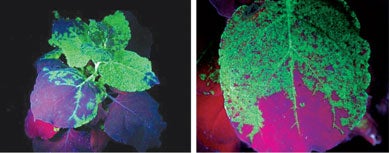discover
IMPROVING EBOLA TESTING
 image: Nicole Steinmetz
A plant (left) and a leaf (right) infected with a green fluorescent potato virus X.
image: Nicole Steinmetz
A plant (left) and a leaf (right) infected with a green fluorescent potato virus X.
A Sierra Leone surgeon tests negative for Ebola. Weeks later, he's dead—of Ebola. A Liberian hospital director is reassured by a negative Ebola test result. A month later, he is dead of Ebola. The false negatives result in tragedy for the patients, and, quite possibly, the unwitting people around them.
Nicole Steinmetz, PhD, assistant professor of biomedical engineering at Case Western Reserve School of Medicine, thinks she can reduce test errors significantly with the help of a virus that attacks tobacco plants. Thanks to a $99,000 National Science Foundation (NSF) grant, she is using her expertise in plant virusesto develop a way to enhance the accuracy of the Ebola test, a result that would save lives if successful.
Steinmetz employs nature's own nanotechnology—viruses—by manipulating them to better diagnose disease, treat lethal blood clots, train the immune system to fight cancer and even make special electronic wiring. Using plant viruses means she can grow her own tools. "All of our work starts in the greenhouse," Steinmetz said. And in the future, some of it will end there too, as new medications are incorporated right into the plants the greenhouse grows. "Edible therapeutics are definitely our long-term vision," she said.
Her Ebola research uses particles from a particular tobacco virus to improve test accuracy; it may be ready by summer.
The first step of the Ebola test can accidentally destroy Ebola's genetic material—its RNA—leading to false negatives. Steinmetz would engineer the tobacco mosaic virus RNA to carry a marker of Ebola virus RNA. Then she would add a known amount of this marked tobacco virus to the first step of the test, along with the blood or tissue being tested for Ebola. If a significant amount of the tobacco virus RNA survives, it would signal that any Ebola RNA would have as well, assuring that a negative result in the second step is no accident. The bigger challenge, Steinmetz said, will be altering the test so it can be performed without electric power and at room temperature, which would dramatically broaden its utility in the developing world—another goal of her laboratory and a problem that will take a lot longer to solve, she said.
The NSF grant is just the latest in a series of grants Steinmetz has received to attack a variety of diseases. Her team, in cooperation with Daniel I. Simon, MD, Herman K. Hellerstein Professor of Cardiovascular Research and president of University Hospitals' Harrington Heart & Vascular Institute, is loading the hollow tobacco mosaic virus with clot-busting medication and then coating its surface with molecules with an affinity for the fibrin in blood clots. Because the virus is oblong, it will bump along artery walls, which enhances its chance of meeting life-threatening clots, hanging on to them, and releasing the medicine it carries.
In a collaboration with Ruth Keri, PhD (GRS '92, pharmacology), professor and vice chair of the Department of Pharmacology and associate director for basic research at the Case Comprehensive Cancer Center, Steinmetz uses the potato virus X to train the immune system to attack cancer. Our immune system ignores cancer because the mutant cells are our own. But the immune system will attack a potato virus. By adding fragments of proteins that are present in certain types of cancers—including breast, ovarian, prostate and pancreatic cancer—Steinmetz and colleagues teach the immune system to attack those proteins as the enemy.
"If you build cancer recognition into the immune system, you would have treatment before doctors could recognize the development of recurrence," she said.






